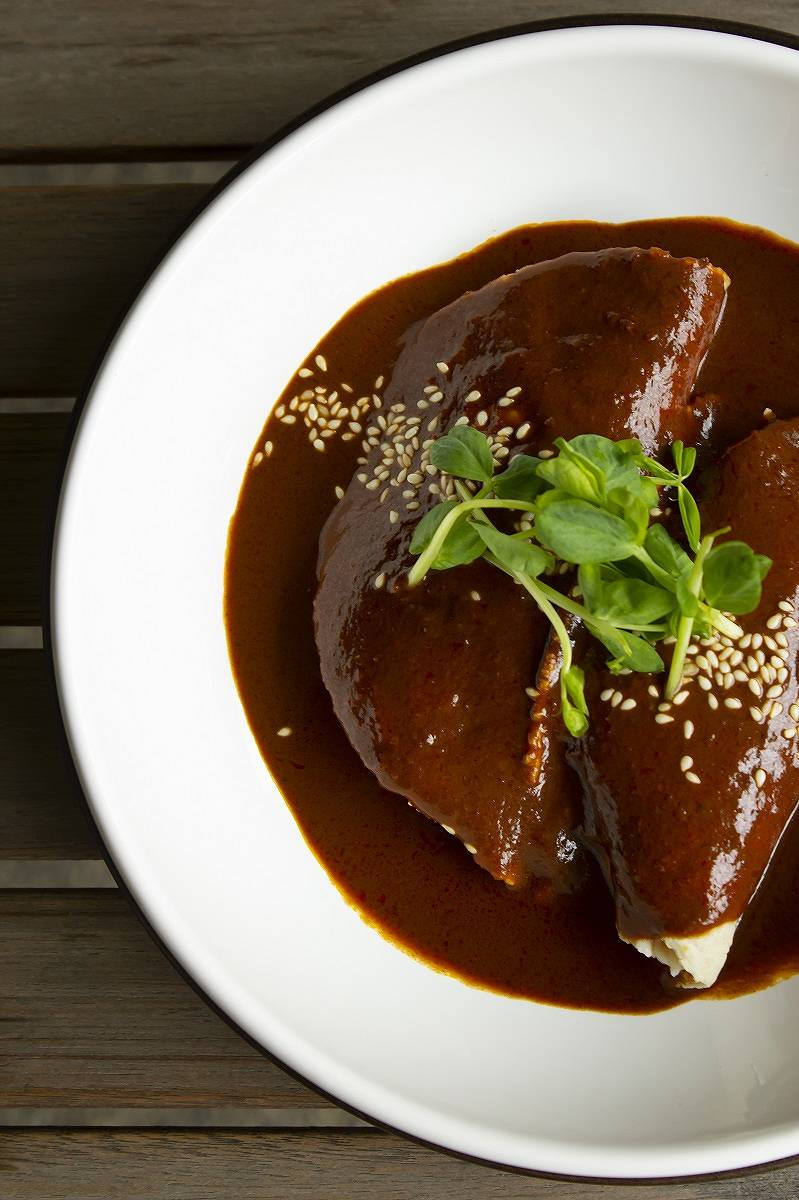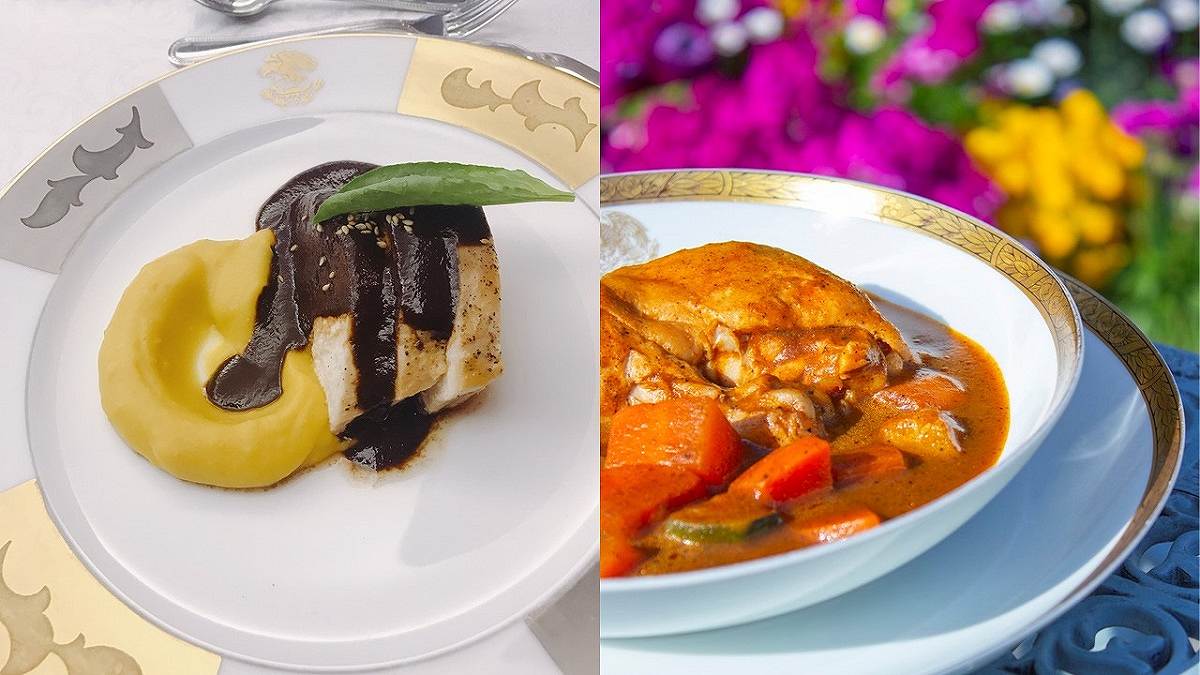
Enmoladas
16:10 JST, December 26, 2023
Today, you might well see tacos, burritos or guacamole on a kitchen table in Japan and not bat an eye. Mexican food has become commonplace, and more and more restaurants here serve up fare from the country. But there is one special sauce that is yet little known in Japan.
And that sauce is mole — pronounced moh-lay.
An essential part of Mexican cuisine, mole literally means “sauce” in the Nahuatl language and is prepared from dozens of ingredients and spices. Many kinds of mole are eaten throughout Mexico, including mole negro (black) and mole verde (green). Mole poblano, which comes from the state of Puebla, is probably the most well-known variant, thanks to its thick and savory nature and inclusion of both chili peppers and chocolate. It’s poured over meat and served with rice or tortillas on the side.
With Japan and Mexico marking 135 years of diplomatic relations in 2023, the Mexican Embassy has chosen mole as its theme for celebration, with promotional events and cooking classes being held and collaborations taking place with hotels and restaurants. The Kaldi Coffee Farm import store, for its part, released ready-made versions of the sauce for a limited time in the summer.
At one event for mole poblano this autumn in Tokyo, 60 guests tried Mexican-Japanese fusion dishes where mole was used on okonomiyaki pancakes or soba noodles. Of course, they also dug in to some more traditional mole fare.
“Mole is a dish with deep roots in the country’s heritage and it is even considered a sacred element of [Mexican] cuisine,” said Luis Rodriguez, senior consultant for the event.
But what is mole really?
“Mole is like a Mexican curry,” said Mexican Embassy chef German Oliva, comparing the texture and consistency of the sauces. It is made from 30 or so ingredients, “So it’s a very complex sauce, very rich in flavors and ingredients,” he said.
Mole goes far back, predating even the arrival of the Spanish in what is now Mexico. But it evolved into its current form after the region was colonized. It was cooked in convents, where foodstuffs brought from Europe — spices, sugar, nuts — were blended with indigenous crops such as tomatoes, chili peppers, cacao and corn. A culinary treasure was forged, helping Mexican cooking win a 2010 designation by UNESCO as part of the Intangible Cultural Heritage of Humanity.
According to Oliva, who was a chef in Mexico and Monte Carlo before coming to Japan, mole consists of six components:
1. Seeds: Sesame seeds, pine nuts, etc.
2. Spices: Cinnamon, pepper, cumin, etc.
3. Dry chili peppers
4. Fresh fruit and vegetables: Tomatoes, onions, garlic, bananas, etc.
5. Thickeners: Tortillas, corn flour, cookies or bread
6. Fat: Lard, oil, etc.
Each ingredient is stir-fried or toasted separately and ground with a stone pestle — or alternatively in a blender — to create a paste, which is thinned a bit with chicken, pork or turkey broth.
Getting a taste

Pollo con mole (mole over chicken), left, Amarillo de Pollo (chicken stew)
Oliva, who hosts a YouTube channel where he teaches viewers to make Mexican food, said it would usually take two to seven hours to make mole.
“Nowadays, we can find mole whenever we want. But for families, we normally have mole when we have a special occasion,” such as a marriage, baptism or funeral, he said, and every family has its own mole recipe.
There are three main ways to eat mole: poured over chicken, pork, turkey or duck (but usually not beef); as enmoladas (rolled tortillas covered with mole); or in tacos.
Some recipes are available on the embassy’s website, and can be found at https://drive.google.com/file/d/1RjNF0eXiBcTGXhRUn8nDiKQS1_ZBR7vf/view?pli=1 , but the easiest way to try the sauce may be to head to a Mexican restaurant. (A map showing the Mexican restaurants in Japan can also be found at https://www.google.com/maps/d/viewer?mid=1GBPrh7gpQxLf5uCQr9vQQlQeiH2dMo65&ll=33.39115768312496%2C134.02464670000003&z=5 )
You might check the menu before heading out, though, as mole is not served at most taco shops, Oliva said. And then, “Some of the restaurants that appear to be Mexican restaurants are Tex-Mex restaurants.”
True Mexican has soft taco shells and corn tortillas, while Tex-Mex uses hard shells and flour tortillas. However, flour tortillas are also eaten in northern Mexico.
To spread knowledge of authentic Mexican cuisine, the embassy gives a certificate to restaurants that finish seven of its classes.
“90% of the Mexican restaurants in Japan are Japanese owned, and the chefs are Japanese,” said Oliva. “We have a very ambitious program. I share with them my recipes and my secrets for Mexican food.”
Of course, if you’re just looking for an easy meal at home, pre-made mole can be found in stores and online. Latin American grocer Kyodai Market in Gotanda, Tokyo, and e-retailer Casa Natural both sell powdered mole that can be mixed with chicken broth. Meat Express, another online shop, offers mole paste.
“In 2023 we were so into promoting mole. Next year we will try to continue sharing mole [with Japanese people],” Oliva said.
He is currently working to develop an instant mole poblano, expected to be released in 2024.
"Features" POPULAR ARTICLE
-

Sanrio to Open Museum in Yamanashi Pref. Dedicated to Founder, Exhibits Include Hello Kitty, Other Characters
-

Autumn Foliage Surrounds Visitors to Tokyo’s Showa Kinen Park
-

My Daughter No Longer Speaks to Me, But I Want to See Her and My Grandchild
-

Kumamoto: Public Bath Refurbished as Library Where You Can Chat, Take Photos
-

Frozen Vegetables: Demand Rises for Convenient, Tasty Domestic Produce
JN ACCESS RANKING
-

Tokyo Economic Security Forum to Hold Inaugural Meeting Amid Tense Global Environment
-

Keidanren Chairman Yoshinobu Tsutsui Visits Kashiwazaki-Kariwa Nuclear Power Plant; Inspects New Emergency Safety System
-

Imports of Rare Earths from China Facing Delays, May Be Caused by Deterioration of Japan-China Relations
-

University of Tokyo Professor Discusses Japanese Economic Security in Interview Ahead of Forum
-

Japan Pulls out of Vietnam Nuclear Project, Complicating Hanoi’s Power Plans
























